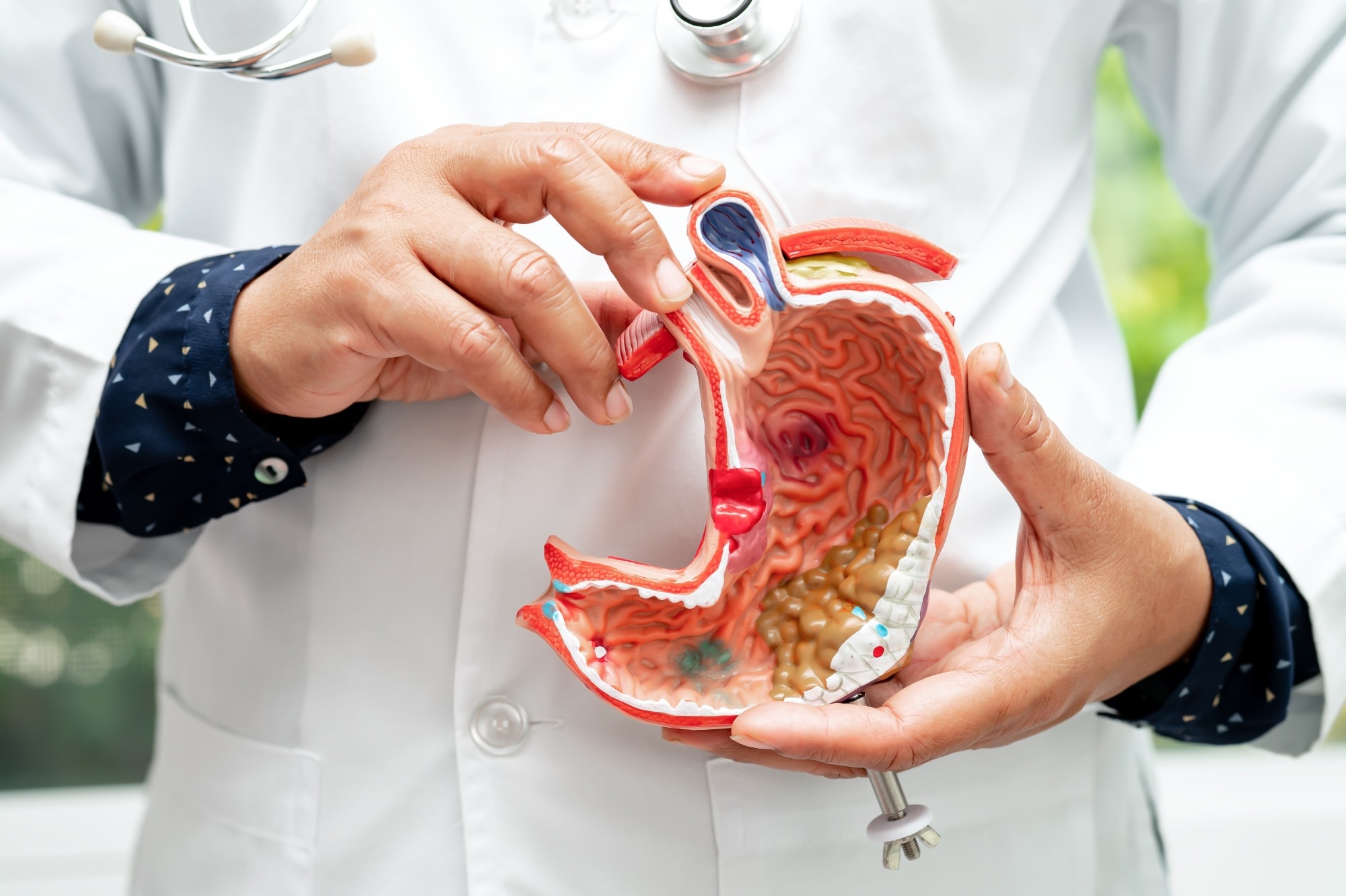In a recent study published in Scientific Advances, researchers created a bioresorbable, cordless, passive sensor that monitors pH locally and detects stomach leakage early on.
 Study: Bioresorbable, wireless, passive sensors for continuous pH measurements and early detection of gastric leakage. Image Credit: sasirin pamai/Shutterstock.com
Study: Bioresorbable, wireless, passive sensors for continuous pH measurements and early detection of gastric leakage. Image Credit: sasirin pamai/Shutterstock.com
Background
Biomarkers surrounding internal organs can give postoperative information, such as intra-abdominal pH changes following stomach surgery. Traditional radiological procedures are neither biocompatible nor appropriate for temporary implants.
An implanted, wireless pH sensor might be the most efficient method for rapid detection. Recent improvements in response-generating hydrogels show promise for point-of-care medical diagnostics.
Incorporating pH-responsive hydrogels into wireless electrical devices may be an effective engineering strategy.
About the study
In the present study, researchers developed a bioresorbable device for early detection of anastomotic leaks following gastric surgery, using passive analog-type wireless communications to ensure rapid reaction times and early clinical outcomes.
A pH-sensitive hydrogel functioned as the transducer, connecting to a mechanically designed inductor-capacitor circuit, enabling wireless reading. The hydrogel is functionalized with pH-responsive-type tertiary amines, resulting in specific, mechanically durable, biodegradable, and pH-responsive hydrogels.
This material provided supporting matrices for inductor-capacitor (LC) resonance circuits, rapidly converting dimensional alterations into resonant frequency shifts in magnitudes measured precisely by inductive connections to external reading devices.
Mechanics models help inform decisions on the optimum hydrogel and circuit component geometries, particularly that of the sensor inductor. Systematic investigations in animals and device setups in vitro confirm the device's continuous pH monitoring ability.
The researchers established the technology's biocompatibility and bioresorbability by histological examinations, complete blood count (CBC) testing, and serum chemistry.
The fabrication technique included combining poly(ethylene glycol)diacrylate (PEGDA), poly[2- (diisopropylamine)ethyl methacrylate (PDPAEMA), and 2,2- dimethoxy- 2- phenyl acetophenone (DMPA), curing the hydrogel with UV radiation, and laser cutting Zn foils to form an inductor with spiral coils.
Molten bioresorbable wax was infused into the channels, resulting in a homogeneous, electrically insulating layer. The location of the inductor and capacitor was determined by demolding the wax-coated Zn coil and casting the pH-responsive hydrogel prepolymer.
The researchers defined the capacitor's top and bottom electrodes by laser-cutting Zn foil discs. The reading system consists of a VNA and a single-turn coil. Setting the VNA to reflective mode allows for measurements of the actual and virtual portions of the S-matrix element S11.
The pH of all buffer solutions and biofluids is calibrated and verified with an ion-sensitive field-effect transistor pH meter.
The study included adult male Lewis rats aged 14-16 weeks acclimatized for up to 7 days before surgery. During the implantation procedure, the rats were given general anesthesia via inhaled isoflurane vapor.
The team conducted functional tests on euthanized pigs and several rat models. They obtained blood samples four, six, and twelve weeks after implantation and preserved the explanted organs in neutral-buffered formalin for histological research.
Results
The platform monitors gastric fluid leakage during the crucial risk phase after laparoscopic sleeve gastrectomy (LSG). It uses wireless readout coils to measure the sensor circuit's resonance frequency, which is affected by the surrounding biological fluid acidity.
Any leaking stomach contents (pH 1.0 to 3.0) infiltrate the hydrogel, causing edema and sudden resonant frequency (FS) shift, necessitating surgical intervention. The device degrades spontaneously following the healing time, reducing the dangers and expenses associated with future extraction operations.
The sensitive part of the monitoring device is the pH-reactive hydrogel enclosed in an inductor with a serpentine spiral shape.
The hydrogel degrades in biological fluids by hydrolyzing the constituent ester groups or ether cleavage during oxidation, rendering it water-soluble, harmless, and removable from the human body. The inductor design seeks to reduce mechanical compliance while maintaining low resistance and a high quality (Q) factor.
Performance assessments centered on the wireless readout showed that the sensor could achieve accuracy across a wide range of approximately 3.0 cm through the air and 2.0 cm through fat and lean tissues.
Non-destructive medical imaging technologies, such as ultrasonography, can aid in determining the precise placement of deployed sensors during routine bedside examinations. Additional trials show that the sensor can respond to acid injected up to 6.0 cm away within an hour.
The researchers used small and large animal models to test stability and appropriate functioning during a seven-day therapeutically relevant timeframe.
The study shows that implantation of a pH sensor in rat models does not harm organ tissues or produce inflammatory responses such as immune cell aggregation.
The study presents a wireless device for postoperative monitoring of gastric leakage and biosorption following surgery. The sensor, which causes water and hydrogen ion diffusion into a biodegradable hydrogel, enables volumetric expansion and inductance changes.
These changes can be wirelessly sensed as shifts in the resonance frequency and recorded via near-field coupling to an external reader. Mechanical models help guide design decisions, and potential enhancements include increasing wireless sensing range and merging tethered and deployable hydrogel device designs.